How to Reset or Change Admin Password on a Mac?

(updated)
Get Free Scanner and check your computer for errors
Fix It NowTo fix found issues, you have to purchase the full version of Combo Cleaner. Free trial available. Combo Cleaner is owned and operated by Rcs Lt, the parent company of PCRisk.com read more.
How to Recover or Reset Administrator Account Password on a Mac Computer?
Nowadays, most of the systems we use require a password to log in. When you're setting up your new Mac, you will be asked to create an administrator account protected with a password. A forgotten password is one example, why you would want to recover or reset Mac's administrator password.
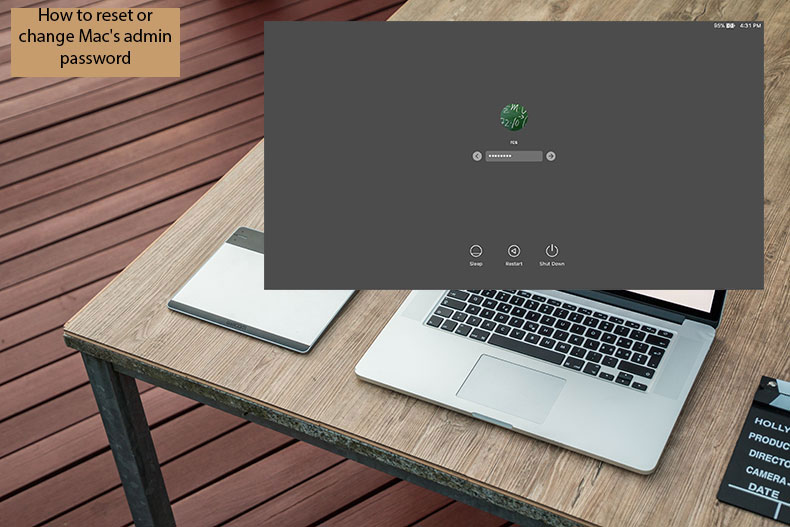
Since a password is an essential protection for your computer and all the private information in it, there is no straightforward way to recover your forgotten password. However, there are a couple of ways to reset or recover lost administrator account passwords. These methods are pretty simple, and even not experienced Mac users will be able to perform them.
Note that the most straightforward method will require an accessible Apple ID and proper settings on your Mac. This article will describe the most common ways to reset or recover Mac's administrator account details and required settings to succeed with each method.
Video showing How to Reset Administrator Password on a Mac?
Table of Contents:
- Introduction
- How to change administrator login details on Mac
- Reset Keychain Access log in a password
- Reset your administrator account password via Apple ID
- Use another account with administrator permissions to reset your password
- Start Recovery Partition to reset the administrator password
- Use the installer CD or DVD
- Recover your administrator password via FileVault
- Use single-user mode to reset your administrator account password
- Use Target Disk Mode to transfer content from locked Mac
- Video showing How to Reset Administrator Password on a Mac?
Download Computer Malware Repair Tool
It is recommended to run a free scan with Combo Cleaner - a tool to detect viruses and malware on your device. You will need to purchase the full version to remove infections. Free trial available. Combo Cleaner is owned and operated by Rcs Lt, the parent company of PCRisk.com read more.
How to change administrator login details on Mac
Changing your account password periodically is good prevention against any kind of unauthorized access to your computer and personal data. If you're using Mac, it is recommended to keep changing login details from time to time to prevent any unwanted access.
Sometimes users attempt to change their password because they suspect that password might have been stolen. There are cases when people realize that using a pet's name or any other family member's name as the primary password is not really good. There might be a lot of reasons why people decide to change their account passwords.
1. To begin the procedure, first, open Mac's System Preferences, then select Users & Groups.
2. When the application is launched, you will see a list of all existing users. Select the account that you want to change password and click the Change Password button.
3. In a new window, you will be asked first to enter the existing password.
4. Then in the following two lines, you have to enter the new one and repeat it again.
5. In the last line, you will have an option to update your hint. We recommend entering the associated hint in case you forget your newly created password.
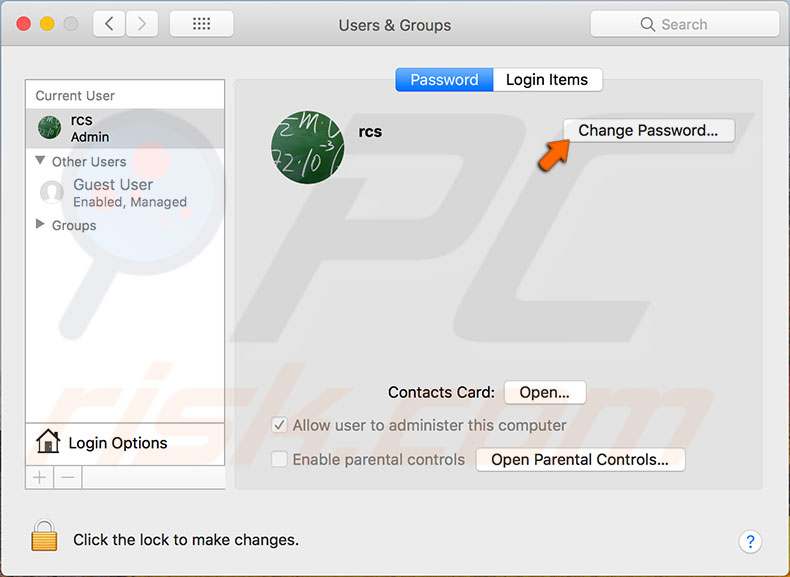
Reset Keychain Access log in a password
Keychain password is a little bit tricky since it is associated with an administrator password. If you reset or recover your Mac's administrator login details, the Keychain password stays the same. When attempting to access your saved password, you still have to enter the old, lost password.
The only real solution, in this case, is resetting the keychain password. However, this results in the loss of all saved credentials until you login with them again.
1. To reset the Keychain password, open the application, click on the title in the menu at the top of your screen, and select Preferences.
2. You will see a Reset My Default Keychains button. Click to proceed. Otherwise, click Edit, select keychain list or keyboard shortcut of Command, Option, and L, then select the login keychain and click on the remove (-) button to delete it.

3. Close your Keychain Access application and restart your Mac computer.
4. After reboot, your keychain will be associated with the new administrator password and begins to collect all your password whenever you log in using them.
If you can't work, reach the reset button or edit the menu in the Keychain Access application. Because various warning messages or login requirements keep popping up, you can reset it through Mac's command line mode.
1. First, boot your Mac into single-user mode by restarting the computer and holding down Command and S buttons while booting.
2. Release the buttons when you see a lot of status messages on your screen with a black background.
3. Once the single-user mode has booted, and status messages stopped appearing, type the following command to mount your operating system as writable, so you will be able to make changes to the filesystem: mount -uw /

4. The next step would be to find out the short name of the account you want to reset, which can be done by checking the list of existing users with the command: ls /Users.

5. Once you know the exact short name of the user, who's Keychain password you're going to reset, replace it with the 'shortname' in the following command and hit return: rm /Users/shortname/Library/Keychains/login.keychain

6. The last step would be to restart your Mac by typing in the command: reboot
After reboot, your keychain will automatically create a new password associated with the changed administrator login details.
Reset your administrator account password via Apple ID
The simplest method to reset your lost or forgotten login details would be to use your Apple ID as a verification method. To use this feature, it must be enabled in your settings.
1. To check if this function is active open your System Preferences and choose Users & Groups.
2. Select your Mac's administrator account and check if there is a checkmark next to 'Allow users to reset the password using Apple ID'. Otherwise, enable the function by clicking in the square.
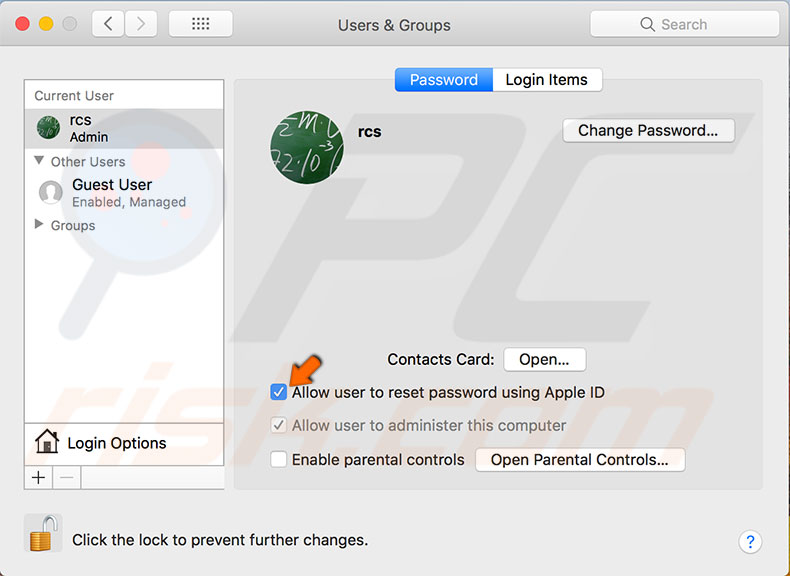
3. You have to enter the wrong password three times while logging in with the administrator account to access this function. After three unsuccessful attempts, the question mark will appear in the password field together with the popup message displaying 'If you forgot your password, you could reset it using your Apple ID'.
4. Choose the option to reset your password using your Apple ID, enter the credentials, and click create a new admin password.
5. Restart your computer, and use a newly created password to access your administrator account.
6. If you realize you don't remember your Apple ID's password as well, you visit Apple's website to recover its password via the traditional email-based method.
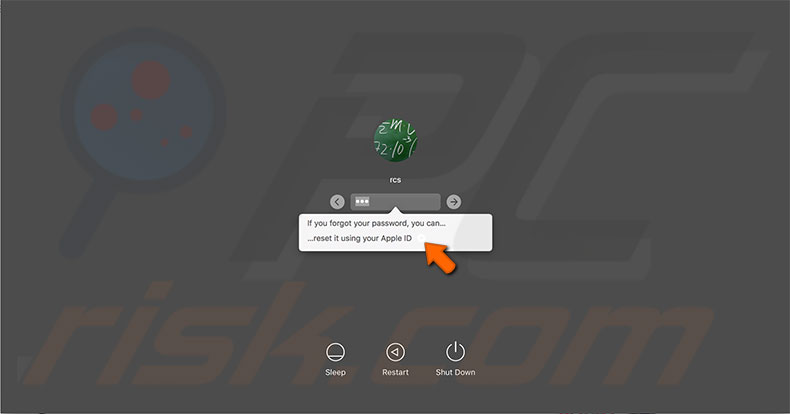
Use another account with administrator permissions to reset your password
Since Mac OS X version 10.4, Apple included a function that allows management administrators account details through another account containing the same permissions. This function was well approved by most IT engineers and some experienced users since it is much easier to recover lost passwords of the leading computer's accounts.
1. To reset the lost password, first, log in to your account. That's the password, you know.
2. Once your Mac is completely booted, open the Systems Preferences and launch the Users & Groups application.
3. Select the user, which password you lost or forgot, and click Reset Password.
4. In the new window, enter the new password, verify by entering the same password again, update hints that could be useful in the feature, and confirm your action by clicking Change Password.
You can log out and then log into your account using the newly created password to access your personal content.
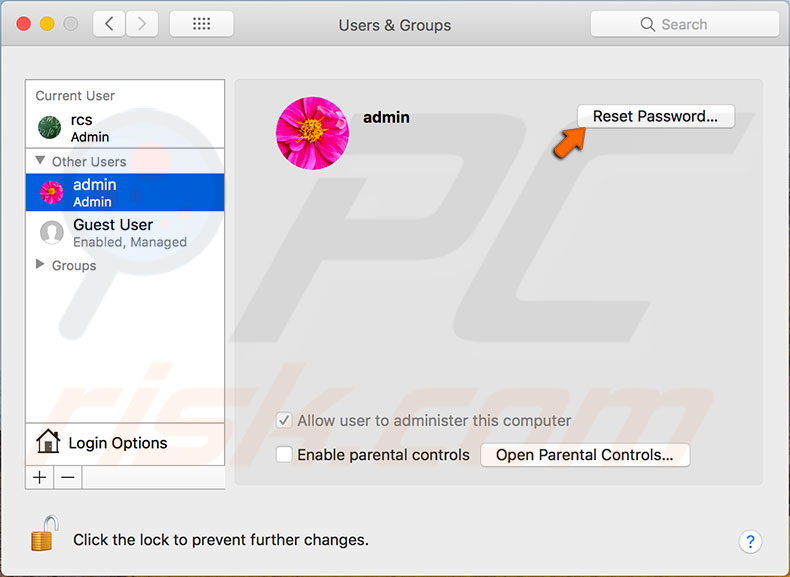
Start Recovery Partition to reset the administrator password
This method is an excellent opportunity when you can't log in to any user on your computer. Since Mac OS X version 10.7, some hidden administrative tools might be used without signing in. In this case, the Recovery Utility menu would help you.
1. To access this tool, first, reboot your Mac immediately after hearing the start-up chime hold down Command and R keys.
2. When you see a Mac OS Utilities window, release the keys.
3. The next step would be to click on Utilities in the menu at the top of your screen and select Terminal.
4. Once Terminal is launched, you will only need to enter the command: resetpassword

5. The new window will appear, giving access to the password just like the Users & Groups application.
6. Select your start-up drive, then select the administrator account.
7. Click the Change Password button and fill in the new password lines.
8. Type in your new password twice and update the hint. Bear in mind, that hint should help you to remember the password.
9. Click save and select the Restart option from the main menu at the top of your screen.
10. Let your Mac boot in the usual way and sign in using your new password.
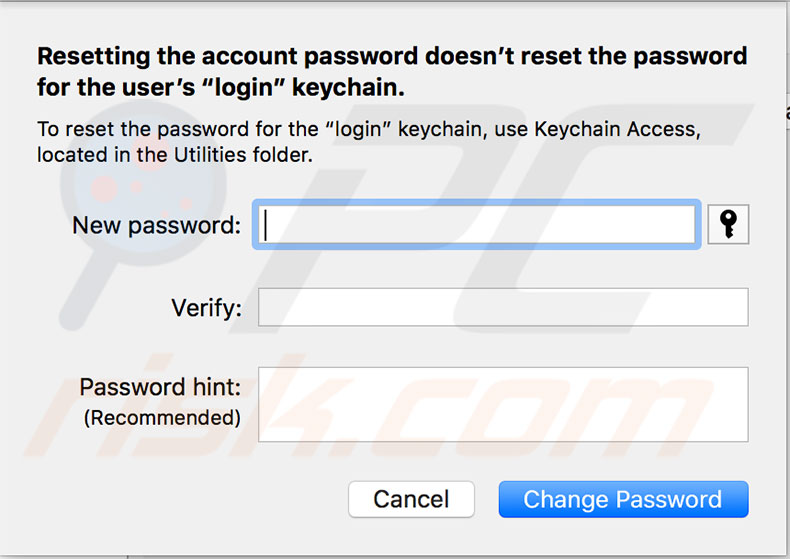
Use the installer CD or DVD
This step is an alternative for users still running on Mac OS X version 10.6 Snow Leopard or earlier. You can reset your administrator password using the install disc. However, this method won't work with Mac OS X version 10.7.
1. To reset the password using the install CD or DVD, first, restart your Mac.
2. When your computer starts booting, insert the disk and immediately hold down the C key on your keyboard. This will demand your Mac to boot from the disc's version of Mac OS X.
3. Click on Utilities in the menu at the top of your screen (or Installer if you're running on the 10.3 Panther version) and choose Reset Password.
4. Further, you have to select the hard disk volume and the name of the original administrator account. (Do not try this method with the Root account). Type in the new password, then click Save.
5. Quit the Installer menu and reboot your Mac in the usual way.
Recover your administrator password via FileVault
With Mac OS X version 10.3, Apple has introduced a content protection feature called FileVault, which uses AES-XTS encryption mode. While this application performs your storage encryption, it automatically generates a recovery key. This key might be used to reset your administrator account password.
1. To begin with, ensure the FileVault is enabled by visiting System Preferences, selecting Security and Privacy, and choosing the FileVault tab.
2. Next, check if you have access to the recovery key, then restart your Mac.
3. When you're at the login screen, select the administrator account and click on the question mark button in the password field.
4. Next, select the option Reset it using your Recovery Key, and enter the recovery key created by FileVault.
5. Now you can type in your new password. Once filled, click Save.
6. Finally, log in with your newly created password.
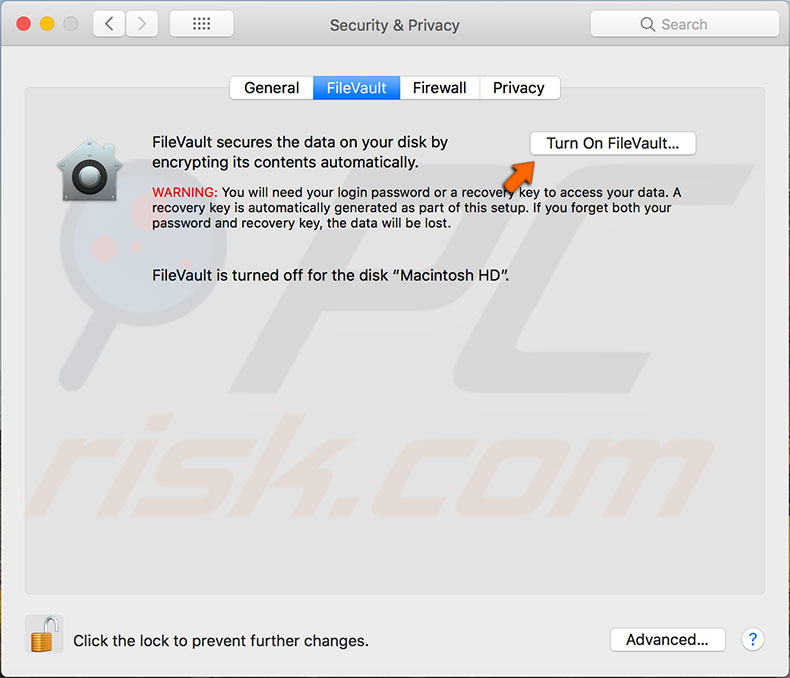
Use single-user mode to reset your administrator account password
This method might look confusing from a first look, but it's probably the leading method between experienced Mac operating system users. However, if you pay attention to the commands we describe below, you will succeed relatively easily and fast.
Bear in mind that upper and lower case and space between words are essential here. We recommend taking a note or photo of the commands we listed below.
1. To begin with, shut down your Mac, then start it up and hold down Command and S to boot your computer into single-user mode.
2. Release the buttons when you see a lot of status messages on your screen with a black background.
3. Once the single-user way has booted and status messages stopped appearing, enter the following command to mount your operating system as writable, so you will be able to make changes to the filesystem: mount -uw

4. Next enter the command: launchctl load /System/Library/LaunchDaemons/com.apple.opendirectoryd.plist
![]()
5. Further, type the password username and hit return.
6. Replace the 'username' with the name of your administrator account, enter the new password, and hit return.
7. Then type your new password again to confirm and hit return.

8. Finally, type reboot and hit return, now. You will be able to sign in with the new password when your Mac boots.
Use Target Disk Mode to transfer content from locked Mac
Finally, if you're about to lose hope, and none of these methods could reset your administrator account password, there still is a way to access the content stored in your locked Mac. Using Target Disk Mode, you can directly transfer the content between Mac computers, just like any external storage.
This way, you can save your important files before you perform a fresh installation of Mac OS. To turn on the Target Disk Mode, you have to follow a couple of simple steps:
1. Completely shut down your locked Mac.
2. Connect your computer to another Mac using FireWire or Thunderbolt cable (unfortunately, you can't use this feature with the regular USB cable).
3. Turn on your locked Mac and hold down the T key while booting.
Followed by these steps, your computer, which you can't access, will become external storage, and you will be able to see it in the other Mac's finder listed as a hard drive. There you will access all content stored on the locked Mac, so you can transfer any required files from it.
Share:

Karolina Peistariene
Author of how-to guides for Mac users
Responsible for collecting, analyzing, and presenting problem-solving solution articles related to macOS issues. Years of macOS experience combined with solid research and analyzing skills help Karolina provide readers with working and helpful solutions as well as introduce various features Mac has to offer.
▼ Show Discussion